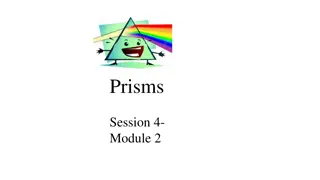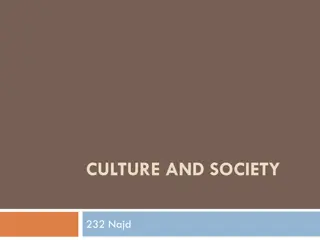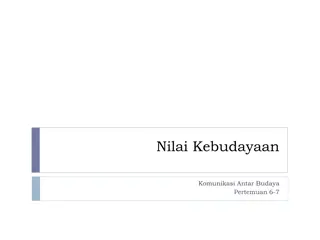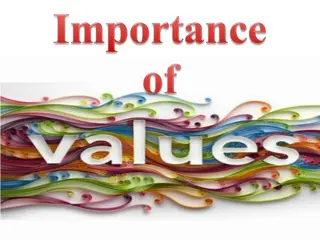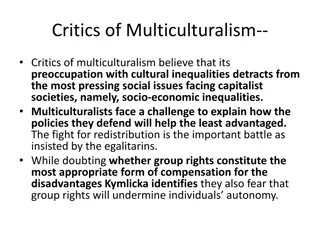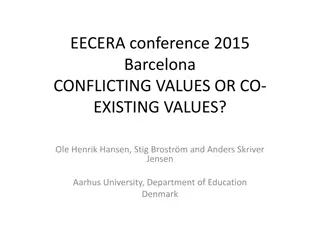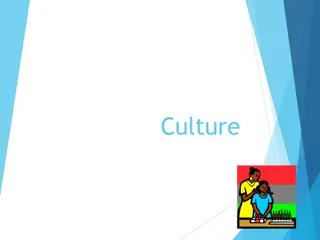Scandinavian Cultural Prisms and Values in Society
Explore the unique cultural prisms and values in Scandinavian society, including perspectives on equal opportunity, preservation of culture, lifestyle pragmatism, and more. Delve into the rich heritage of the region, from egalitarian values to social systems that prioritize quality of life over quantity, reflecting a blend of tradition and modernity.
Download Presentation

Please find below an Image/Link to download the presentation.
The content on the website is provided AS IS for your information and personal use only. It may not be sold, licensed, or shared on other websites without obtaining consent from the author.If you encounter any issues during the download, it is possible that the publisher has removed the file from their server.
You are allowed to download the files provided on this website for personal or commercial use, subject to the condition that they are used lawfully. All files are the property of their respective owners.
The content on the website is provided AS IS for your information and personal use only. It may not be sold, licensed, or shared on other websites without obtaining consent from the author.
E N D
Presentation Transcript
CHAPTER 6 Scandinavian
Scandinavian Culture PRISMS 1. What is culturally best: equal opportunity vs. equal results? 2. Should a nation s government strive to preserve its culture? 3. Lifestyle pragmatism: Should the state be values-neutral? 4. Jante law: Are some people better than others? 5. Unisex culture: Should women be treated differently than men?
Individualism Extended family Community Monochronic Poychronic Low Context High Context Social Ambiguity Social Certainty Low Power Distance High power Distance Mastery Adaptation Emotionally Neutral Emotionally Expressive Quantity of Life Quality of life
SCANDINAVIAN SCANDINAVIAN
Egalitarian values: equal results, not just equal opportunity
1. It is virtually impossible to become rich in Sweden, because the taxes are so high and the income differentials are so low. Thus there s not much of a difference in the way people live because there isn t much of a difference in spendable income. 2. Both Swedish parents are entitled to up to a year in paternity leave. If a child has a significant illness, a parent can can take up to 60 days off at 90% pay. 3. Ombudsmen are readily available to represent workers in conflicts with their employer.
In contrast to Americans, most Scandinavians believe in equal results rather than merely equal opportunity (because no society can truly provide equal opportunity for everyone) A Scandinavian millionaire paid a $174,000 speeding ticket because that equaled the same percentage of his income as a $200 fine for the common wage earner.
COMMON CAREER BARRIERS FACED BY AMERICAN WOMEN 1.Loss of workplace seniority when having or caring for children 2.Subordinating the wife s career to the husband's career, especially when job transfers are involved 3.Working in a male corporate climate based on competition rather than cooperation & autocratic decision- making rather than participative
Equal opportunity doesn t exist. People aren t equally intelligent & skilled. Highly imperfect & rigged economic systems don t give everyone a fair opportunity to provide for their needs.
How many people pay the price of your eco success? High taxes are the foundation of economic equality & social stability.
You arent more important than anyone else. ( Jante law ) Caring means sharing. People s basic needs must be met by community sacrifice.
ORIGINS OF SECURITY CULTURE IN MODERN SCANDINAVIA 1. Ethnically homogeneous population (promoting a strong social conscience) 2. A class-free society 3. Geographic isolation & the hostile northern climate 4. Strong feminine influence within the culture
The (cradle to grave) welfare state Free health care, college, pregnancy leave, even euthanasia
CHILD POVERTY COMPARISONS 1. Scandinavian countries have the lowest child poverty rates in the world thanks to their welfare system; in Denmark just 2.4% of children live in poverty; 3.4% in Norway; 4.2% in Sweden 2. Mexico & the U.S. have the highest child poverty rates in the developed world: 27.7% for Mexico & 21.9% for the U.S.
WHY HASNT AMERICA PURSUED CRADLE TO GRAVE WELFARE? 1. Opposition to & the lack of communal consciousness perhaps due to America s ethnic & religious diversity. 2. Higher income Americans have more ways to legally reduce their taxes than the middle class 3. Sales taxes, which America strongly relies on for tax revenue, discriminate against lower income Americans (who pay the same tax as rich Americans).
1. Scandinavians have a strong sense of community responsibility. There is a willingness to make adjustments which other cultures might consider a sacrifice of individuality. 2. Violent crime rates are low throughout most Scandinavian cultures. Only 6% of Swedes report being victims of violence. 3. Despite high divorce rates, a high rate of unmarried parents, and shifting relationships, the number of people who live alone in isolation has not increased over time.
WHERE THE AMERICAN EMOTIONAL PROFILE DIFFERS MOST FROM THE SCANDINAVIAN 1. Greater American propensity for risk- taking & uncertainty 2. American tend to be more aggressive & competitive 3. The American cult of personality (movie stars, rock stars, etc.) 4. American social status differences are based largely on money & conspicuous consumption (Kardashian hyper- materialism, extravagant weddings, mansions for homes, lifestyle excesses of rock stars, entertainers, & pro athletes, etc.)
5. American culture is less libertarian (no rules for morality ) than Scandinavians because the Judeo-Christian ethic still has some influence in America & there is also a strain of religious personal piety left in America. 6. Americans are more Darwinian ( survival of the fittest ) than Scandinavians based on the success-orientation of Americans & rugged individualism. 7. Americans are more tolerant of class differences (based on wealth & standard of living) than Scandinavians.
8. Americas commercialized culture has generated an entire industry of promoters, agents, PR consultants to manufacture glamorous, larger-then- life celebrities who are icons of America wealth, success, & fame. Scandinavians prefer real people to celluloid holographs. 9. Swedish-born American actress Greta Garbo (famous in the 1930 s & 1940s) quit the movie business at the peak of her popularity and became a recluse because she couldn't stand being worshipped for her beauty and celebrity.
THE ULTIMATE UNISEX CULTURE 1. Scandinavian parents share household duties more than any other culture, including child- rearing. 2. Scandinavia leads the world in women elected to political office, sitting on boards, & holding executive corporate positions. This reflects the Scandinavian tradition of androgynous (masculine/feminine blend) organizational cultures.
3. The workplace equality of Scandinavian women is bolstered by generous paid pregnancy leave that enables women professionals not to lose their seniority level (the major reason women professionals in many other nations are paid less even when doing the same job as male counterparts). 4. Widespread utilization of across-the- board pay increases (vs. merit pay, which lends itself to corporate politics) also adds to Scandinavian greater workplace equality for women.
SCANDINVIAN LIFESTYLE PRAGMATISM 1. The Dutch acknowledge that morals can t be legislated, as illustrated by the failure of Prohibition in the U.S., & don t want to criminalize those addicted to vices. 2. Legalized prostitution and pornography 3. Government-provided drugs, abortions, and euthanasia (including babies with traumatic problems) 4. Highest percentage of cohabitating couples 5. State-sponsored euthanasia
CULTURE OF THE SCANDINAVIAN WORKPLACE
1. Job security 2. Teamwork & consensus decision- making 3. Across-the-board compensation 4. Interpersonal sincerity & informality 5. Avoidance of interpersonal competition & aggressive business practices (reflecting the egalitarian mindset of Scandinavians: We re all in the same boat together )
6. Downplaying artificial status differences ( Jante law : Don t think you re better than others ) based on physical attractiveness, wealth, fame, or religious affiliation. 7. Compromise viewed as a favorable option 8. Non-confrontational conflict avoidance & win-win decision-making 9. Reflecting Jante law, Scandinavians tend to dress plainly & behave in a low key manner to avoid calling attention to themselves (for fear of implying that they are better than others).



